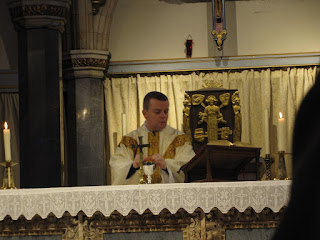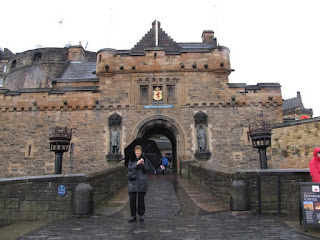 |
| As I said the decor is a little macabre! |
 |
| The view from the library down to the bar |
 |
| We sat in the window box and enjoyed a couple of pints . . . |
 |
| . . . and delicious fish & chips. |
 |
| The inside is beautiful. Blue accent lights were on making it look more blue than it actually is. |
 |
| We did not immediately notice the Blessed Sacrament was exposed! |
 |
| The mas was lightly attended and after mass, Fr Nick welcomed us warmly. |
 |
| This appeared to be a relic of St Faustina but we could not verify that |
 |
| The St Andrew Square is close by and is being decorated for Christmas |
 |
| The National Bank of Scotland just across from St ANdrew's Square |
 |
| The view from the West side of St Abdrew's square includes a nice view of the Sir Walter Scott Memorial |
 |
| The Maxwell's Equations (in "point" form) |
 |
| This building was decked out for Christmas! |
 |
| This statue memorializes George IV |
 |
| This view is from the crircle where the George IV statue is looking South toward the Royal Scottish Academy |
 |
| Continuing down George Street, this statue memorializes William Pitt (the younger) who at age 24 became Britain's youngest Prime Minister in 1783 |
 |
| This monument is a tribute to The Royal Scot Grey Regiment that fought in the Boer War at the turn of the century |
 |
| At this point, we leave Prince Street and New Town, and start along "The Mound" and area leveled by a great amount of fill, and are headed toward Old Town and the Castle |
 |
| This stately looking building is New College |
 |
| A memorial to The Black Watch Regiment |
 |
| The Scotch Whiskey Experience - For a price you can taste some very fine whiskeys |
 |
| The front of the castle now opens onto a large esplanade. |
 |
| On the sides of the entrance are statues of Robert the Bruce and William Wallace (Braveheart) |
 |
| Ens Ewart was a Sergeant when he fought through many French troops to capture the Royal French Standard at Waterloo. He is interred on the Esplanade. |
 |
| Theresa pauses on the Argyle Battery |
 |
| The Scott Memorial |
 |
| The view of New Town from the Castle Hill |
 |
| Looking up from the Argyle Battery |
 |
The Castle is still a garrison and some buildings are off limits to tourists |
 |
| The walk up wasn't bad and gave us a chance to study some of the buildings |
 |
| The recruits on guard duty were pretty cute! |
 |
| The view from the west - it was driving rain when I took this photo and I found one spot where I could be in the lee of a building! |
 |
| This looks like a chapel but is actually the back of the National Memorial to those who have fallen in battle. |
 |
| This is the front of the National War Memorial. No photos were allowed inside out of respect for the fallen |
 |
| The Unicorn is the symbol for Scotland . . . |
 |
| . . . while the Lion symbolizes England |
 |
| This small graveyard is for military dogs! |
 |
| The Chapel of St Margaret is the oldest structure on the hill and dates to the 12th Century. It has been restored and is a popular wedding site, although it will only hold a couple dozen people! |
 |
| This window is of St Columba who brought Christianity to Scotland in 563. |
 |
| Ronnie, our guide was very well informed with a dry wit. |
 |
| The upper (Half Moon) battery |
 |
| This view from the upper battery |
 |
| The Great Hall was the scene of dinners and parties |
 |
| The ceiling is all wood - including fastening pegs. Possibly built by shipwrights. |
 |
| The huge fireplace is flanked by weaponry |
 |
| The Royal Palace and a display of the Scottish Crown Jewels |
 |
| The Royal Palace was occupied by Queen Mary who gave birth to James (who became King of England & Scotland) here. |
 |
| This chart tells the tale of the lineage of the royalty of Scotland |
 |
| This relief shows the use of the Stone of Scone as the symbol of coronation of the King of Scotland. Legend has it that Fergus, son of Eric was the first person so "crowned" |
 |
| This depicts Robert the Bruce being crowned King of Scotland |
 |
| The sword was also an important symbol of power indicating authority over life and death. |
 |
| This display concerned the Stone of Scone (Destiny). Captured by the English and placed under the Royal Throne, it came to symbolize English dominance. |
 |
| It was stolen by college students in the 1950's and restored to Scotland |
 |
| The stone was formally returned to Scotland by the Queen with the proviso it would come to London for the coronation |
 |
| There was quite a display regarding the making of the Scottish Honours |
 |
| This depicts Mary as a girl, before she was sent to France where she was raised, and behind her, as an adult who returned to Scotland. |
 |
| The Royal Honours were threatened by Cromwell and as a consequence were hidden |
 |
| When Cromwell died, the Royal Honours were retrieved intact |
 |
| The One O'clock Gun fires precisely at One O'clock to allow the ships in the harbor (who don't have satellite or mobile phone coverage) to know the time |
 |
| This prison was used during the Revolutionary War but the American prisoners were not awarded the status of POW since they were in "rebellion" |
 |
| The prisoners passed their time with games and making some very fine craft pieces |
 |
| This indictment is on the door of a cell in the military prison where British were interred. I noticed it since the man was named Ewing - a good friend from Indiana |
 |
| Poor Private Ewing! |
 |
| This siege cannon is called Mons Meg and was basically for intimidation. |
 |
| Someone overfilled the charge one day (or possibly, the powder mix was too "hot" - mixing gunpowder was as much art as science back then) and burst poor Meg. |
 |
| On the way down to the gate . . . |
 |
| . . . we noticed "Free Whiskey tasting! |
 |
| We ended up buying a small bottle (which we had to consume in Kirkwall/Stronsay since we were planning on only carry-on bags back to Dublin. |
 |
| . . . and a burglar and thief at night! (The two sides of the sign). We considered eating there but the prices reflected the robbery side of the sign! |
 |
| So we ended up back at Jekyll & Hydes again. Bob had this Yorkshire pudding-filled-with-meatballs pie. . . |
 |
| . . . along with a pole of onion rings (which he shared!) |
 | ||||||
| While Theresa went with a smothered (with cheese - what else) chicken. |





















No comments:
Post a Comment